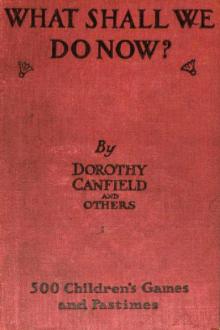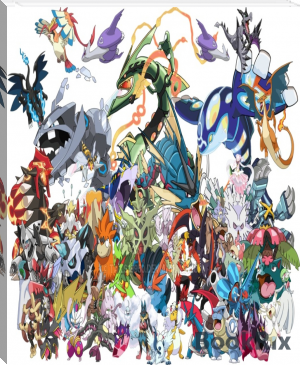What Shall We Do Now?, Dorothy Canfield Fisher [ebook offline reader .txt] 📗

- Author: Dorothy Canfield Fisher
- Performer: -
Book online «What Shall We Do Now?, Dorothy Canfield Fisher [ebook offline reader .txt] 📗». Author Dorothy Canfield Fisher
If the farmer has the new wooden hives with a glass covering he will very likely let you peep in and see the bees at work. Before doing this you certainly ought to read something about their exceedingly wonderful ways. One of the best books is Sir John Lubbock's (Lord Avebury's) Ants, Bees, and Wasps, but most encyclopædias contain very interesting articles on the subject.
The CowsThe man who looks after the cows is a very valuable friend. He may even let you try to milk, which only specially gifted children ever succeed in doing at all well; and he will teach you the cows' names (in some farms these are painted up over each stall—Primrose, Lightfoot, Sweetlips, Clover, and so on); and perhaps he will give you the task of fetching them from the meadow at milking time.
SheepIn a general way sheep are not very interesting, especially in low-lying farms. But though sheep, as a rule, are dull, there are two occasions when they are not—at sheep-washing and sheep-shearing. The washers stand up to their knees, or even their waists, in the brook, in oilskin clothes, and seizing the struggling sheep one by one by the wool, plunge them into the water. Shearing is a finer art; but the sheep is hardly less uncomfortable. He has to be thrown into various positions (on his back for one, and with his head between the shearer's knees for another), while the shears clip-clop all over him. The wool is not taken off in scraps, as our hair is at the barber's, but the whole fleece is removed in one huge piece.
The BlacksmithIt may be that while you are at the farm the day will come for having the horses shod, and you may go with them to the blacksmith. The blacksmith is of course a very important person to be friends with; and people are very fortunate if their lodgings in the country are close to a smithy. Some blacksmiths permit their friends to stand right inside the smithy, instead of just at the door, where strangers have to stay. Perhaps the blacksmith will ask you to blow his bellows while he is making a horseshoe, and it may happen that if he has not much work on hand he will make you a hoop that will be far cheaper and stronger than a bought one (see p. 169). In hot weather the flies are so troublesome to horses which are being shod, and make them so restless, that some one has to stand beside them and brush the flies away with a green branch. This job might fall to you.
Birds'-NestingOne of the advantages of being in the country in spring is that that is the time when birds build. In May the weather is not yet sufficiently warm to make sitting about out-of-doors very comfortable, but birds'-nesting can make up for that. It is of no use to say in this book, "Don't take the eggs," because it is possible only for one person here and there to be satisfied with merely finding a nest and then passing on to find another. But it is a pity for any one who is not a serious collector to take more than one egg. For your purposes one is enough, and the loss of a single egg rarely causes a bird to desert her nest. Of course if you know for certain that the nest is deserted, it is right to take all. You can find out by visiting it two or three times, and if the eggs remain cold or wet and there is no sign of the bird you may safely feel that she has abandoned them. Birds have so many natural enemies to fear that it is hard that we should harm them too.
Blowing EggsFor blowing eggs a brass or glass blow-pipe is the proper thing, using only one hole, which is made at the side with a little drill. But for your purpose a hole at each end made with a pin is simpler and equally good. In blowing you must be careful not to hold the egg so tightly in the fingers that its sides crush in. Before making the holes it is well to put the egg in a basin of water. If it sinks it is fresh and can be blown easily; but if it floats it is set—that is to say, the young bird has begun to form—and blowing will be difficult. In such cases it is wise, if you are using a blow-pipe, to make a largish hole and put a little water in and leave the egg to lie for a day or so; then blowing it will be not much trouble. But if you have no blow-pipe the best thing to do is to make one good-sized hole in the less interesting side of the egg, and empty it with a bent pin. Then, when it is empty, you can put it in the egg box with the broken side underneath. Country boys often thread birds' eggs on a string which hangs from the ceiling, but the ordinary way is to put them in cotton-wool in a box with cardboard compartments. Making this box is a good country occupation for wet weather.
ButterfliesButterfly-hunting begins when birds'-nesting is done and the weather is hot. Here again it is not the purpose of this book to go into particulars: the subject is too large. It is enough to say that the needful things are a large net of soft green gauze, a killing-bottle with a glass stopper, a cork-lined box with a supply of pins in which to carry the butterflies after they are dead, and setting boards for use at home. The good collector is very careful in transferring the butterfly from the net to the bottle, lest its wings are rubbed or broken; and before taking it out of the bottle and putting it in the box you should be quite certain that it is dead. The way to get the butterfly into the bottle is to drive it into a corner of the net and hold it there, and then slip the bottle inside, remove the stopper, and shake the butterfly into it. The stopper should be off as short a time as possible. For handbooks for a butterfly collector see the "Reading" section.
Collecting FlowersA quieter pastime, but a very interesting one, and also one that, unlike egg-collecting and butterfly-collecting, goes on all the year round, is collecting flowers. For this purpose tin cases are made, with straps to hold them from the shoulders, in which to keep the plants cool and fresh; but there is no need to wait for the possession of one of these. An ordinary box or basket will, if you have not very far to walk, serve equally well. You will also need a press, which can be simply a couple of boards about a foot long and six inches wide, with a good supply of blotting-paper between. The flowers are pressed by spreading them very carefully, to show their beauty to best advantage, between the blotting-paper, and then piling a few books on the boards. The weight need not be very heavy and the blotting-paper should frequently be renewed. You will soon learn how long the pressing need continue, but it is of the highest importance that the flowers are thoroughly dried before you mount them in your album or on separate sheets of paper. The simplest form of mounting is to glue little strips of paper here and there across the stems. A botanical collection is more valuable if the roots of the plants are also included; and this will make it necessary for you to have a long trowel. For the collector of flowers a handbook is compulsory. Such a book as Alice Lounsberry's The Wild Flower Book for Young People gives many details of the growth and nature of plants, told with a story that makes the book unusually interesting, and will arouse your enthusiasm to gather wild flowers and see how large a collection of them you can make.
It is interesting, if you have any skill in painting, to make water-color copies of all the flowers that you find; another good occupation for wet days in the country.
Nuts and BlackberriesIn nutting you want a hooked stick with which to pull down the branches. For blackberries a hooked stick is not so important, but it is well to have leather gloves. The blackberries ought to be dry when they are picked. Rain takes their flavor away; so you should wait until the sun comes again and restores it. One thing that you quickly notice is that all blackberries are not after the same pattern. There are different kinds, just as there are different kinds of strawberry and raspberry. Some are hard and very closely built; some are loosely built, with large cells which squash between the fingers; some come between these two varieties; and there are still others. For eating on the spot the softer ones are the best, but for cooking and for jam the harder ones are equally good.
In picking blackberries you soon find that it is better to have the sun at your back, because if it shines through the bush into your eyes you cannot distinguish clearly between the shades of blackness. An open basket full of blackberries is a radiant sight. Each of the little cells has a point of light, and thousands of these together are as gay as jewels.
No one need starve on the open road in September, for there is food on every hedge—two good courses. Nuts are there as the standby, the backbone of the meal, and after come blackberries, as pudding or dessert. To pick the two for an hour, and then, resting beneath a tree, to eat until all are gone—that is no bad way to have lunch. If you take advice in this matter, you will not crack the nuts with your teeth but between stones.
Ponds and Sailing BoatsNear the farm is certain to be either a pond or a stream. If it is a clean and high pond, not in a hollow surrounded by trees, it will be good to sail boats on. Sailing boats on inland water is much better than on the sea, because, with a pond, directly the boat is fairly started on its voyage you can run round the other side and meet it. Even with a very poor pond it is still possible to have a very good time. In buying or making a boat, be sure that the lead along the keel is heavy enough. So little do toy-shop people think of these things that they very often put no lead at all on their boats, and more often than not put too little. Once a boat is properly weighted in this way you are certain to have fun in sailing her, but otherwise it will be useless to try. In boat-sailing it is well to have a long stick with a hook at the end with which to draw the ship to land. For suggestions as to making a useful and simple sailing-boat see p. 295.
Little Boats on a StreamSailing boats in a stream is little good, because there is no steadiness of wind, but ordinary boats will float along in the current splendidly. It is interesting to launch one and follow its adventures from the bank. Sometimes it will be caught in a weed; sometimes an eddy will sweep it into





Comments (0)